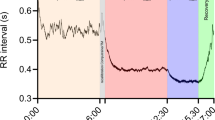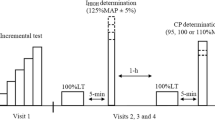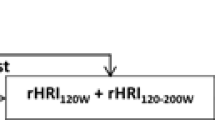Abstract
The overload principle of training states that training load (TL) must be sufficient to threaten the homeostasis of cells, tissues, organs, and/or body. However, there is no “golden standard” for TL measurement. The aim of this study was to examine if any post-exercise heart rate variability (HRV) indices could be used to evaluate TL in exercises with different intensities and durations. Thirteen endurance-trained males (35 ± 5 year) performed MODE (moderate intensity, 3 km at 60% of the maximal velocity of the graded maximal test (vVO2max)), HI (high intensity, 3 km at 85% vVO2max), and PRO (prolonged, 14 km at 60% vVO2max) exercises on a treadmill. HRV was analyzed with short-time Fourier-transform method during rest, exercise, and 15-min recovery. Rating of perceived exertion (RPE), blood lactate (BLa), and HFP120 (mean of 0–120 s post-exercise) described TL of these exercises similarly, being different for HI (P < 0.05) and PRO (P < 0.05) when compared with MODE. RPE and BLa also correlated negatively with HFP120 (r = −0.604, −0.401), LFP120 (−0.634, −0.601), and TP120 (−0.691, −0.569). HRV recovery dynamics were similar after each exercise, but the level of HRV was lower after HI than MODE. Increased intensity or duration of exercise decreased immediate HRV recovery, suggesting that post-exercise HRV may enable an objective evaluation of TL in field conditions. The first 2-min recovery seems to give enough information on HRV recovery for evaluating TL.


Similar content being viewed by others
References
American College of Sports Medicine (2006) ACSM’s guidelines for exercise testing and prescription, 7th edn. Lippincott Williams & Wilkins, Philadelphia, pp 19–35
Arai Y, Saul J, Albrecht P, Hartley L, Lilly L, Cohen R, Colucci W (1989) Modulation of cardiac autonomic activity during and immediately after exercise. Am J Physiol 256:H132–H141
Aunola S, Rusko H (1984) Reproducibility of aerobic and anaerobic thresholds on 20–50 year old men. Eur J Appl Physiol 53:260–266
Banister E (1991) Modelling elite athletic performance. In: MacDougall JD, Wenger HA, Green HJ (eds) Physiological testing of the high-performance athlete, 2nd edn. Human Kinetics Publishers Ltd, Champaign, pp 403–424
Berntson G, Cacioppo J, Quigley K (1993) Respiratory sinus arrhythmia: autonomic origins, physiological mechanisms, and psychophysiological implications. Psychophysiology 30:183–196
Borg G (1982) Psychophysical bases of perceived exertion. Med Sci Sports Exerc 14:377–381
Børsheim E, Bahr R (2003) Effect of exercise intensity, duration and mode on post-exercise oxygen consumption. Sports Med 33:1037–1060
Buchheit M, Laursen P, Ahmaidi S (2007) Parasympathetic reactivation after repeated sprint exercise. Am J Physiol Heart Circ Physiol 293:H133–H141
Casties J-F, Mottet D, Le Gallais D (2006) Non-linear analysis of heart rate variability during heavy exercise and recovery in cyclists. Int J Sports Med 27:780–785
Cole C, Blackstone E, Pashkow F, Snader C, Lauer M (1999) Heart-rate recovery immediately after exercise is a predictor of mortality. N Engl J Med 341:1351–1357
Foster C (1998) Monitoring training in athletes with reference to overtraining syndrome. Med Sci Sports Exerc 30:1164–1168
Goldberger J, Le F, Lahiri M, Kannankeril P, Ng J, Kadish A (2006) Assessment of parasympathetic reactivation after exercise. Am J Physiol 290:2446–2452
Gore C, Withers R (1990) The effect of exercise intensity and duration on the oxygen deficit and excess post-exercise oxygen consumption. Eur J Appl Physiol 60:169–174
Kaikkonen P, Nummela A, Rusko H (2007) Heart rate variability dynamics during early recovery after different endurance exercises. Eur J Appl Physiol 102:79–86
Kaikkonen P, Rusko H, Martinmäki K (2008) Post-exercise heart rate variability of endurance athletes after different high-intensity exercises. Scand J Med Sci Sports 18:511–519
Keselbrener L, Akselrod S (1996) Selective discrete Fourier transform algorithm for time-frequency analysis: method and application on simulated and cardiovascular signals. IEEE Trans Biomed Eng 43:789–802
Martinmäki K, Rusko H (2008) Time-frequency analysis of heart rate variability during immediate recovery from low and high intensity exercise. Eur J Appl Physiol 102:353–360
Martinmäki K, Rusko H, Saalasti S, Kettunen J (2006) Ability of short-time Fourier Transform to detect transient changes in vagal effects on hearts: a pharmacological blocking study. Am J Physiol 290:2582–2589
Miles D, Sawka M, Hanpeter D, Foster J, Doerr B, Basset Frey M (1984) Central hemodynamics during progressive upper and lower body exercise and recovery. J Appl Physiol 57:366–370
Noble B (1982) Clinical applications of perceived exertion. Med Sci Sports Exerc 14:406–411
O’Leary D (1993) Autonomic mechanisms of muscle metaboreflex control of heart rate. J Appl Physiol 74:1748–1754
Oida E, Moritani T, Yamori Y (1997) Tone-entropy analysis on cardiac recovery after dynamic exercise. J Appl Physiol 82:1794–1801
Perini R, Orizio C, Comandè A, Castellano M, Beschi M, Veicsteinas A (1989) Plasma norepinephrine and heart rate dynamics during recovery from submaximal exercise in man. Eur J Appl Physiol 58:879–883
Pichon A, De Bisschop C, Roulaud M, Denjean A, Papelier Y (2004) Spectral analysis of heart rate variability during exercise in trained subjects. Med Sci Sports Exerc 36:1702–1708
Pierpont G, Stolpman D, Gornick C (2000) Heart rate recovery post-exercise as an index of parasympathetic activity. J Auton Nerv Syst 80:169–174
Plotnick C, Becker L, Fisher M (1986) Changes in left ventricular function during recovery from upright bicycle exercise in normal persons and patients with coronary artery disease. Am J Cardiol 58:247–251
Porges S (1992) Vagal tone: a physiologic marker of stress vulnerability. Pediatrics 90:498–504
Savin W, Davidson D, Haskell W (1982) Autonomic contribution to heart rate recovery from exercise in humans. J Appl Physiol 53:1572–1575
Seiler S, Haugen O, Kuffel E (2007) Autonomic recovery after exercise in trained athletes: intensity and duration effects. Med Sci Sports Exerc 39:1366–1373
Skinner J, Hustler R, Bergsteinova V, Buskirk E (1973) The validity and reliability of a rating scale of perceived exertion. Med Sci Sports 5:97–103
Acknowledgments
This study was funded by grants from TEKES-National Technology Agency of Finland, Emil Aaltonen Foundation and Foundation of Sports Institute. The results of the present study do not constitute endorsement by ACSM.
Author information
Authors and Affiliations
Corresponding author
Additional information
Communicated by Susan Ward.
Rights and permissions
About this article
Cite this article
Kaikkonen, P., Hynynen, E., Mann, T. et al. Can HRV be used to evaluate training load in constant load exercises?. Eur J Appl Physiol 108, 435–442 (2010). https://doi.org/10.1007/s00421-009-1240-1
Accepted:
Published:
Issue Date:
DOI: https://doi.org/10.1007/s00421-009-1240-1




